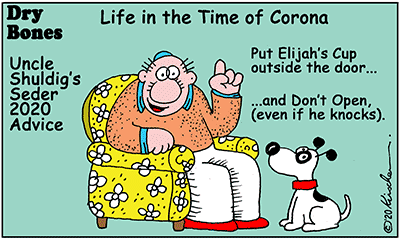‘Science will conquer this’: Inside the race for a coronavirus treatment
In a small lab on the Givat Ram campus of the Hebrew University in Jerusalem, Professor Shy Arkin and his team of three are “throwing chemicals” at some of the proteins that constitute the coronavirus, hoping that one or more of them will stick.British-Israeli Project Aims to Identify Anti-Covid-19 Drug
Or at least that’s the kind of non-scientific language Arkin helpfully uses to describe the frantic research that is taking place in his and thousands of other labs around the world, in the battle to counter the pandemic that has gradually brought much of human endeavor and interaction to a near-halt.
In whichever constrained environment this article finds you, therefore, you’ll be pleased to hear that he’s optimistic. The virus, Arkin acknowledges, is particularly devastating among the elderly and other high-risk groups. But social distancing is at least a partially effective interim measure, buying time for the scientific community to come up with a real solution. And that solution, he is confident, will be found.
Arkin is among the scientists who feel they have something of a head start in the race to stop the pandemic, having spent close to two decades studying the components of influenza and SARS 1, the current COVID-19’s “remarkably similar predecessor,” which killed 774 people in 2002-3. And he says that at least some of COVID-19’s two dozen or so components are proteins that are known to be “drug-able” — that scientists have been able to inhibit.
The particular race in which his and all those thousands of other labs are frantically engaged is to test some 6,000 chemicals — drugs that are already approved as non-toxic to humans — against the virus’s constituent compounds: “You throw chemicals at it… If one of the chemicals inhibits a component, and that component is crucial to the virus, the chemical is immediately a potential antivirus drug.”
Sounds simple? Well, yes and no, as this interview attempts to make clear.
It was conducted on Sunday, first in Arkin’s office and then, briefly, in his small lab — one of the very few places on the university campus still working. We kept the obligatory two meters apart as we spoke — a task that became slightly more difficult when we entered the lab, and two members of his team showed me some of the testing process.
The Times of Israel: So, how goes the search for a coronavirus treatment?
Prof. Shy Arkin: We’re working in frantic mode. We’re a small team, and we are serving chemicals against a component of the virus that we identified many years ago.
Teams at the Weizmann Institute for Science in Israel and the Diamond Light Source laboratory in Oxfordshire outlined their current findings and research plans in a discussion hosted by Weizmann UK on Thursday. Weizmann Vice President for Public Affairs and Resource Development Roee Ozir said, "We have probably somewhere between 20 and 30 initiatives of talented and creative scientists who are trying to push their research very quickly and look for remedies as soon as possible."World Health Organization insists coronavirus not an airborne disease as experts raise possibility
Dr. Nir London, who is leading the team at Weizmann that is searching for a drug candidate, said they are seeking to develop an anti-viral drug which will target protease, one of the 30 proteins that are essential for the activity of the virus. The Weizmann Institute and its international partners are seeking to conduct multiple stages of its research concurrently and thereby shorten the research cycle.
Weizmann has pioneered a form of research that is "completely open and shared in real time with the entire scientific community." To find the compounds that are able to inhibit protease, "instead of following up on only a few tens of compounds, we aim to follow up on 500 to a 1,000 compounds in parallel and so drastically shorten the timescale," London said.
The team published the data that they had gathered online and issued a "call to arms to medical chemists around the world" inviting them to submit proposals for which compounds might be best placed to bind to the coronavirus. "Within a few days, we got hundreds of proposals from medicinal chemists all around the world....Our premise is that if there is a safe compound which shows efficacy against the virus, humanity needs to know about this fast."
The World Health Organization doubled down on its claim that the COVID-19 virus is not transmittable by air even as some experts suggest it is possible and as Western officials recommend that doctors and nurses take precautions.”
“FACT: #COVID19 is NOT airborne,” WHO declared in a Saturday fact-check tweet. "The #coronavirus is mainly transmitted through droplets generated when an infected person coughs, sneezes, or speaks.”
But a study in the United States suggests otherwise. Carried out by more than a dozen health experts working with the National Institute for Health’s Rocky Mountain Laboratories, the study released this month found "aerosol … transmission of SARS-CoV-2 is plausible, since the virus can remain viable and infectious in aerosols for hours.”
One of the authors of the study that was published in the New England Journal of Medicine, Jamie Lloyd-Smith, a UCLA professor and infectious disease researcher, told the Los Angeles Times that singing may have spread virus through the air at a church in Washington state, where a choir rehearsal in early March was deemed the cause of a fatal coronavirus outbreak.
Polly Dubbel, a county communicable disease manager, told the Los Angeles Times that airborne transmission at the Mount Vernon Presbyterian Church was “all we can think of right now.”
She told the Washington Examiner: “It was a group of approximately 60 people just singing in close proximity to each other for over an hour — they weren’t eating, they weren’t shaking hands, they weren’t engaging in any other high-risk activities — and that’s all we know.”
One early March study in Singapore also suggested "that small virus-laden droplets may be displaced by airflows and deposited on equipment such as vents.” A non-peer-reviewed study out of China stated that the intensive care unit, the cardiac/coronary care unit, and general patient rooms in one Wuhan hospital and the patient hall inside another “had undetectable or low airborne SARS-CoV-2 concentration.”
The Centers for Disease Control and Prevention’s most recent disinfection guidelines state “based on what is currently known about the virus … spread from person-to-person happens most frequently among close contacts (within about 6 feet).” The guidance adds that “this type of transmission occurs via respiratory droplets, but disease transmission via infectious aerosols is currently uncertain.












































